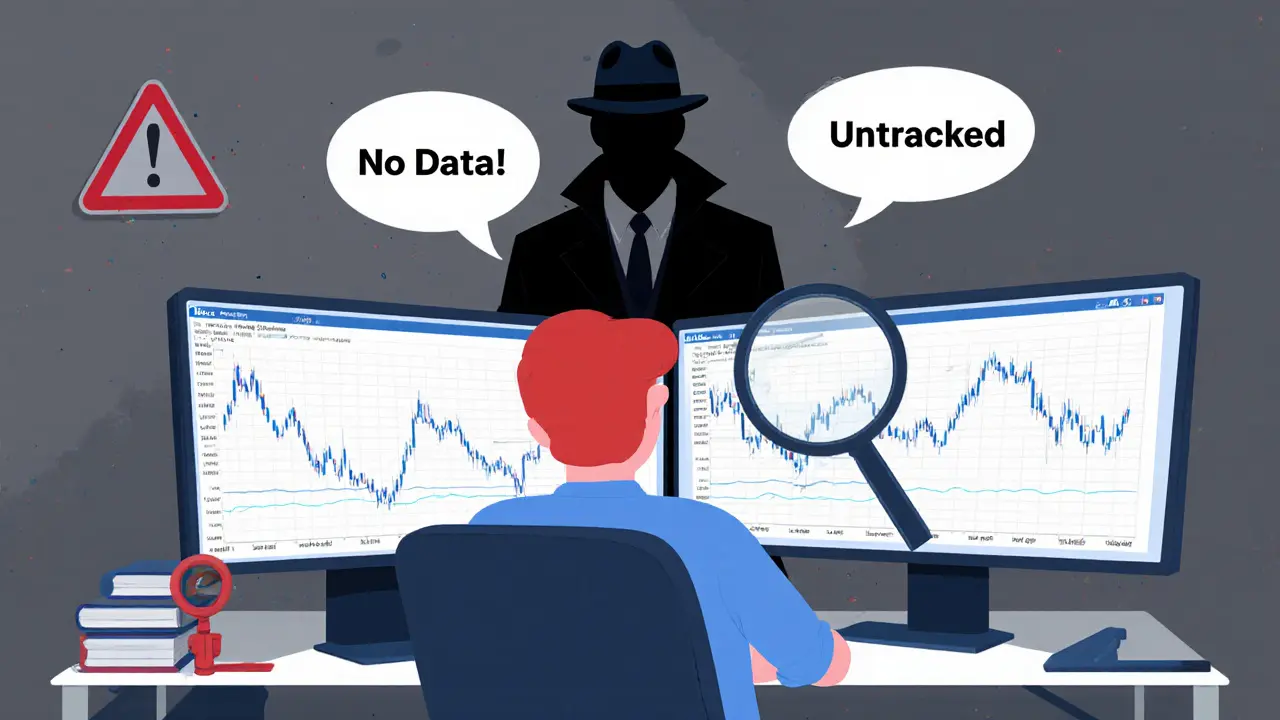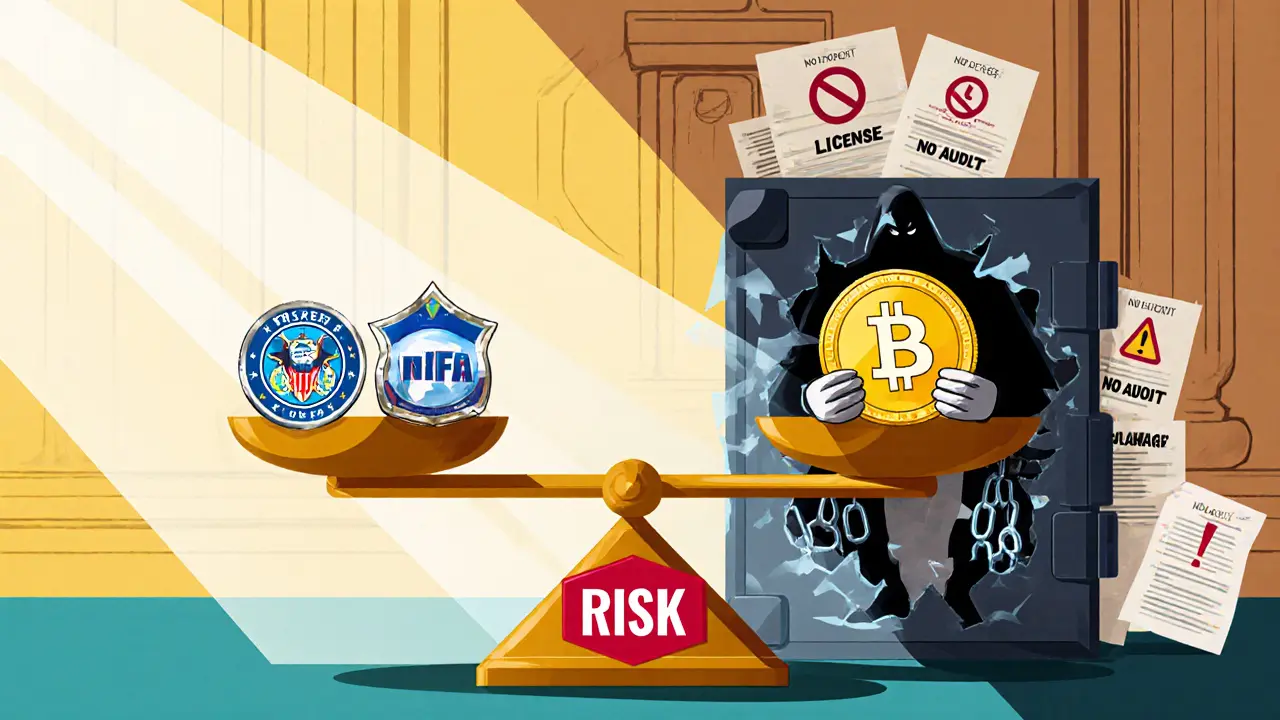
- 10 Mar 2025
- Elara Crowthorne
- 17
Triunits Exchange Risk Assessment Tool
Trading Transparency
Lack of real-time trading data and volume indicators
Regulatory Compliance
No disclosed licensing or regulatory registration
Security Measures
Unverified wallet technology and discretionary refund policy
User Experience
Outdated interface and sparse user engagement
Risk Summary
Overall Risk Level: High
Based on current evidence, Triunits Exchange presents significant risks due to lack of regulatory oversight, transparent trading data, and verified security practices.
Comparison with Regulated Exchanges
| Feature | Triunits Exchange | Regulated Exchange (e.g., Binance, Kraken) |
|---|---|---|
| Trading volume transparency | Untracked, no public data | Live 24-hr volume displayed on multiple aggregators |
| Regulatory registration | None disclosed (potentially unregistered) | Registered with relevant authorities (CFTC/NFA, FCA, etc.) |
| Security audits | None published | Third-party audit reports available |
| User support & community | Sparse, outdated forums, limited live chat | 24/7 support, active social channels, community hubs |
| Fee structure | 0.2% per trade (flat) | Tiered fees, discounts for volume, clear schedule |
| Staking yields | High advertised rates, no verifiable proof | Audited rates, transparent reward distribution |
Quick Takeaways
- Triunits Exchange markets itself as India’s largest crypto venue but shows no real‑time trading data on major trackers.
- Community reviews flag broken charts, obscure volume and a largely abandoned interface.
- Regulatory gaps are evident - the platform offers derivatives without clear CFTC or local licensing.
- Security claims (cold/hot wallets, elite security team) lack independent verification.
- For most traders, proven, regulated exchanges remain the safest choice.
When you first hear about Triunits Exchange is a cryptocurrency platform that describes itself as India’s largest crypto exchange, launched on July 18, 2020, and based in Kolkata. The site promises spot, margin, futures, staking, mining pools and an on‑chain wallet-all under one roof. On paper it sounds appealing, especially for users in over 130 countries looking for a “one‑stop shop.” But does the service deliver, or is it another headline‑rich scam?
What Triunits Claims to Offer
Triunits markets a fairly standard suite of products:
- Spot trading: buying and selling assets instantly at market price.
- Margin & futures: leveraged positions that amplify gains - and losses.
- Staking services: lock up coins and earn a monthly interest rate.
- Mining pools: collective hash power for miners looking to share rewards.
- On‑chain wallet: a hot‑wallet for daily transactions and a cold‑wallet for long‑term storage, allegedly built by “the world’s top security team.”
The fee schedule appears modest - a 0.2% charge per transaction - and the UI is glossy, with promotional banners for high‑yield staking and “professional” trading tools.
Red Flags: No Volume, No Data
Legitimate exchanges publish live order‑book depth, trade history and 24‑hour volume. Triunits falls short on every front. CoinMarketCap lists the platform as an “Untracked Listing” and explicitly notes that “Volume data is untracked.” All trading pairs show “No data is available now,” and the depth charts simply stay blank.
Without transparent volume you can’t gauge liquidity, slippage risk or market relevance. In the crypto world, the absence of public data is a classic warning sign - most reputable venues are integrated with aggregators like CoinMarketCap, CoinGecko or CryptoCompare to provide real‑time metrics.

User Experiences: Community Skepticism
First‑hand accounts paint a bleak picture. A detailed review on Revain.org points out that the platform “has been little used,” its charts stopped loading and volume figures remain “obscure.” The reviewer, who posted on July182021, also highlighted “lots of blank spaces” throughout the interface and a general sense of abandonment.
Another thread on BeerMoneyForum.com debates whether Triunits is a “SCAM or LEGIT.” While the site’s marketing sounds promising, forum members note that the platform’s only public footprint is a static website - no social proof, no active Telegram or Discord community, and no recent software updates.
Regulatory Compliance Gaps
Triunits advertises futures and derivatives trading to a global audience, including U.S. residents. In the United States, the U.S. Commodity Futures Trading Commission (CFTC) requires any entity offering derivatives to register with the CFTC and become a member of the National Futures Association (NFA). There is no evidence that Triunits holds such registrations, nor does the platform list any local licensing in India, the EU or other jurisdictions.
Operating without proper registration exposes users to legal uncertainty - funds could be frozen, and there is little recourse if the exchange disappears.
Security Claims vs. Reality
Triunits boasts a “cold and hot wallet technology developed by the world’s top security team.” Yet there are no third‑party audits, no published security white‑paper, and no bug‑bounty program. Independent security firms routinely audit reputable exchanges (e.g., CertiK, Quantstamp) and publish reports. The lack of any such audit for Triunits makes the security narrative suspect.
Moreover, the platform’s refund policy grants it “broad discretionary power” to retain or deduct amounts before returning balances to users. In practice, this means if a dispute arises, the exchange can lock funds indefinitely.

Side‑by‑Side Comparison
| Feature | Triunits Exchange | Regulated Exchange (e.g., Binance, Kraken) |
|---|---|---|
| Trading volume transparency | Untracked, no public data | Live 24‑hr volume displayed on multiple aggregators |
| Regulatory registration | None disclosed (potentially unregistered) | Registered with relevant authorities (CFTC/NFA, FCA, etc.) |
| Security audits | None published | Third‑party audit reports available |
| User support & community | Sparse, outdated forums, limited live chat | 24/7 support, active social channels, community hubs |
| Fee structure | 0.2% per trade (flat) | Tiered fees, discounts for volume, clear schedule |
| Staking yields | High advertised rates, no verifiable proof | Audited rates, transparent reward distribution |
Risk Assessment & Recommendation
Based on the evidence, here’s a quick risk breakdown:
- Liquidity risk: No visible order book means you could face severe slippage or be unable to exit a position.
- Regulatory risk: Absence of licensing exposes you to legal action and potential fund seizure.
- Security risk: Unverified wallet tech and discretionary refund terms undermine fund safety.
- Operational risk: Broken charts and stale UI suggest the platform may no longer be maintained.
For casual traders or investors, the safest route is to stick with exchanges that publish real‑time data, hold recognized licenses, and provide third‑party security audits. If you’re attracted by the high staking yields advertised by Triunits, remember that unusually high returns are often a lure used by fraudulent platforms.
In short, the gaps are too wide to overlook. Until Triunits offers transparent volume, verifiable audits and clear regulatory compliance, treat it as a high‑risk venue - potentially a scam.
Frequently Asked Questions
Is Triunits Exchange a regulated crypto exchange?
No public records show that Triunits holds a license from the CFTC, NFA, FCA or any comparable regulator. The lack of disclosed registration is a major red flag.
Can I see real‑time trading volume on Triunits?
No. CoinMarketCap labels the platform as an “Untracked Listing,” and the exchange’s own UI shows blank volume fields for all pairs.
What do user reviews say about the platform?
Reviews on Revain.org and discussions on BeerMoneyForum.com describe broken charts, obscure volume, and a largely abandoned product with very few active users.
Are the staking yields advertised by Triunits realistic?
The platform provides no audit or proof of how staking rewards are generated. Historically, unusually high yields often signal a Ponzi‑style scheme.
Should I consider using Triunits for margin trading?
Given the lack of transparent order‑book data, regulatory clearance, and security audits, margin trading on Triunits is extremely risky. Stick with a regulated exchange that offers clear leverage limits and insurance funds.

17 Comments
Hey folks, before you jump onto any exchange, take a step back and run the basics. Verify if the platform publishes live order‑book data, and check if it’s listed on reputable aggregators like CoinGecko. Look for clear regulatory disclosures-if they’re missing, that’s a red flag. Also, read community feedback; a few negative reviews can be a warning sign. Lastly, never invest more than you can afford to lose, especially on newer services.
Having examined the Triunits Exchange review in detail, I find it essential to articulate a comprehensive perspective that balances caution with an appreciation for the nuances of emerging crypto platforms. First and foremost, the absence of verifiable trading volume data constitutes a material deficiency that undermines confidence in liquidity and price discovery. Moreover, the platform’s failure to disclose any licensing or registration with recognized financial authorities such as the CFTC, NFA, or FCA raises legitimate concerns about regulatory compliance. While the advertised fee structure appears modest at a flat 0.2 percent per trade, the lack of transparent fee tiers makes it difficult to benchmark against industry standards. The security narrative, which touts an “elite security team,” is not corroborated by any independent audit reports from firms such as CertiK or Quantstamp. In practice, the omission of third‑party audit documentation leaves users vulnerable to potential custodial risks. Additionally, the platform’s user interface demonstrates several signs of neglect, including broken charts and stale forum activity, which may indicate a waning commitment to ongoing development. From a consumer protection standpoint, the discretionary refund policy grants the exchange unilateral authority to withhold or deduct funds, a clause that could be weaponized in dispute scenarios. The cumulative effect of these factors is a heightened risk profile that users should weigh carefully against any potential rewards. It is also worth noting that high advertised staking yields, absent verifiable proof, are a classic hallmark of schemes that prioritize attraction over substance. Consequently, prudent investors should prioritize exchanges that provide real‑time data feeds, audited security measures, and clear regulatory status. Should you decide to allocate capital to Triunits, I recommend limiting exposure to a small, experimentally sized portion of your portfolio, thereby mitigating downside risk. Finally, remain vigilant for any future updates from the platform that address the identified shortcomings, as transparency and compliance are dynamic attributes that can evolve over time. In summary, while Triunits presents an intriguing product suite, the lack of critical safeguards warrants a cautious, highly measured approach to participation. Stay informed and share your findings with the community to help others navigate these waters.
i cant believe ppl actually trust that sketchy platform.
Wow, that was a thorough breakdown! I love how you highlighted the missing volume data and the shady refund policy-those are real deal‑breakers. The comparison table really drove the point home with crystal‑clear visuals. If anyone is still on the fence, I’d say stick with exchanges that publish audits and have solid community support. Keep sharing these insights; they’re a lifesaver for newcomers.
Let’s be real: anything that hides its order‑book is a playground for the shadowy hands that manipulate markets behind a curtain of anonymity. The fact that Triunits claims to offer futures to U.S. residents without any CFTC registration is practically an invitation for regulatory scrutiny. Their so‑called “elite security team” could just be a front for a group of tech‑savvy scammers waiting to disappear with user funds. Even the “high‑yield staking” feels like a classic Ponzi lure, promising returns that are mathematically impossible without some hidden mechanism. I’ve seen similar platforms vanish overnight after collecting a few big deposits, leaving the rest of the community holding the bag. The blank charts and stale forums are not just technical glitches; they’re symptoms of a platform that’s no longer being maintained. In a world where every crypto exchange touts transparency, silence is a red flag screaming louder than any marketing slogan. Bottom line: treat this site with extreme skepticism and keep your assets on proven, regulated venues.
Honestly, reading this feels like watching a melodrama where the hero is a shady exchange and the villains are the unsuspecting traders. The “glossy UI” is just a shiny façade hiding broken charts and ghost towns of users. Their high‑yield promises are nothing but bait, and the lack of audits is the ultimate plot twist. If you value your crypto, walk away from the theatrics and choose a stage‑tested exchange.
It’s clear, from a risk‑management perspective, that the platform’s opacity, in terms of both volume data and regulatory licensing, makes it a questionable choice, especially for those who prioritize security and transparency. Additionally, the discretionary refund policy introduces an element of uncertainty that could affect fund recovery, should disputes arise.
Thanks for the balanced overview! 🌟 It really helps to see both the pros and cons laid out so clearly.
Good info. If an exchange doesn’t show volume, it’s hard to trust. Stick with places that are open about their numbers.
The pursuit of financial freedom through crypto must be tempered by a sober assessment of risk. When an exchange conceals fundamental data, it erodes the trust essential for any marketplace. Transparency, therefore, becomes a moral imperative. Choose platforms that respect this principle.
Whoa-look at how many red flags this place has!!! No license, no audits, no real volume-just a glossy front!!! If you value your money, avoid it like the plague!!!
Ths review is sooo helpful-thanks! I love how u pointed out the blank charts and the missing regs. It’s like a puzzle piece fitting in place. Gotta be super careful with these untracked sites.
I understand the lure of high yields, but the lack of verifiable data makes it risky. It’s better to keep assets where you can see the numbers clearly. Stay safe.
What a rollercoaster this article was! From glossy promises to glaring gaps, the story of Triunits reads like a cautionary tale. I’m amazed at how many warnings are buried in plain sight. The missing volume alone is a siren’s wail for traders. Add in the regulatory vacuum, and it feels like walking a tightrope over a canyon. Still, some still chase the glitter-don’t be one of them. Keep your eyes open and your crypto where it belongs-on trustworthy exchanges.
Sure, the red flags are loud, but some users claim they’ve had smooth trades there. Maybe the platform is just under the radar, not a scam. Still, I’d keep a tiny amount for testing, just in case.
Looks like Triunits is missing the basics most exchanges have. I’d stick with the big names unless they get legit updates.
It is utterly unacceptable that a platform would operate without any regulatory oversight, putting users’ hard‑earned money at stake. Such negligence is a betrayal of trust and must be condemned. Users deserve transparency, audits, and legal protection-none of which Triunits offers. I urge everyone to stay away until they meet the basic standards of compliance.